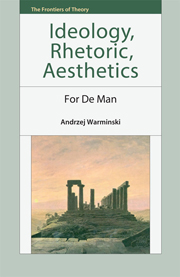Book contents
- Frontmatter
- Contents
- Series Editor's Preface
- Author's Preface
- Acknowledgements
- List of Abbreviations
- PART I Aesthetic Ideology
- 1 Allegories of Reference: An Introduction to Aesthetic Ideology
- 2 “As the Poets Do It”: On the Material Sublime
- 3 Returns of the Sublime: Positing and Performative in Kant, Fichte, and Schiller
- 4 Lightstruck: “Hegel on the Sublime”
- PART II Hegel/Marx
- PART III Heidegger/Derrida
- Appendix 1 A Question of an Other Order: Deflections of the Straight Man
- Appendix 2 Response to Frances Ferguson
- Index
1 - Allegories of Reference: An Introduction to Aesthetic Ideology
from PART I - Aesthetic Ideology
Published online by Cambridge University Press: 05 October 2013
- Frontmatter
- Contents
- Series Editor's Preface
- Author's Preface
- Acknowledgements
- List of Abbreviations
- PART I Aesthetic Ideology
- 1 Allegories of Reference: An Introduction to Aesthetic Ideology
- 2 “As the Poets Do It”: On the Material Sublime
- 3 Returns of the Sublime: Positing and Performative in Kant, Fichte, and Schiller
- 4 Lightstruck: “Hegel on the Sublime”
- PART II Hegel/Marx
- PART III Heidegger/Derrida
- Appendix 1 A Question of an Other Order: Deflections of the Straight Man
- Appendix 2 Response to Frances Ferguson
- Index
Summary
“La fonction reférentielle est un piège, mais inévitable”
Aesthetic Ideology
The texts collected in Aesthetic Ideology were written, or delivered as lectures on the basis of notes, during the last years of de Man's life, between 1977 and 1983. With the possible exception of the earliest text – “The Concept of Irony” (1977) – all of these essays and lectures were produced in the context of a project that we might call for short-hand purposes a critique or, better, a “critical-linguistic analysis” of “aesthetic ideology.” This project is clearly the animating force of all the essays de Man produced in the early 1980s -and not just those explicitly concentrating on philosophical aesthetics to be included in the book project he called Aesthetics, Rhetoric, Ideology, but also the essays on literary critics and theorists like Riffaterre, Jauss, and Benjamin that made up a second of de Man's book projects -part of which appeared posthumously as The Resistance to Theory (1986) -as well as the two late essays (on Baudelaire and Kleist) expressly written for the collection The Rhetoric of Romanticism (1984). Although the general project is recognizable throughout these texts, it takes different forms in the context of the three particular book projects.
The essays on Riffaterre and Jauss, for example, demonstrate how both the critic whose point of departure is based on “formalist” presuppositions and the critic whose point of departure is based on “hermeneutic” presuppositions depend on the category of the “aesthetic,” indeed on a certain “aesthetization,” to negotiate the passage between the formal linguistic structures and the meaning of the literary texts they interpret.
- Type
- Chapter
- Information
- Ideology, Rhetoric, AestheticsFor De Man, pp. 3 - 37Publisher: Edinburgh University PressPrint publication year: 2013



